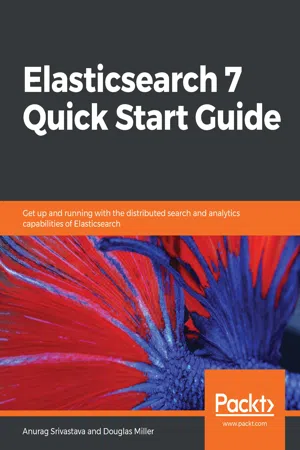
Elasticsearch 7 Quick Start Guide
Get up and running with the distributed search and analytics capabilities of Elasticsearch
- 186 pages
- English
- ePUB (mobile friendly)
- Available on iOS & Android
Elasticsearch 7 Quick Start Guide
Get up and running with the distributed search and analytics capabilities of Elasticsearch
About This Book
Get the most out of Elasticsearch 7's new features to build, deploy, and manage efficient applications
Key Features
- Discover the new features introduced in Elasticsearch 7
- Explore techniques for distributed search, indexing, and clustering
- Gain hands-on knowledge of implementing Elasticsearch for your enterprise
Book Description
Elasticsearch is one of the most popular tools for distributed search and analytics. This Elasticsearch book highlights the latest features of Elasticsearch 7 and helps you understand how you can use them to build your own search applications with ease.
Starting with an introduction to the Elastic Stack, this book will help you quickly get up to speed with using Elasticsearch. You'll learn how to install, configure, manage, secure, and deploy Elasticsearch clusters, as well as how to use your deployment to develop powerful search and analytics solutions. As you progress, you'll also understand how to troubleshoot any issues that you may encounter along the way. Finally, the book will help you explore the inner workings of Elasticsearch and gain insights into queries, analyzers, mappings, and aggregations as you learn to work with search results.
By the end of this book, you'll have a basic understanding of how to build and deploy effective search and analytics solutions using Elasticsearch.
What you will learn
- Install Elasticsearch and use it to safely store data and retrieve it when needed
- Work with a variety of analyzers and filters
- Discover techniques to improve search results in Elasticsearch
- Understand how to perform metric and bucket aggregations
- Implement best practices for moving clusters and applications to production
- Explore various techniques to secure your Elasticsearch clusters
Who this book is for
This book is for software developers, engineers, data architects, system administrators, and anyone who wants to get up and running with Elasticsearch 7. No prior experience with Elasticsearch is required.
Frequently asked questions
Information
Aggregating Datasets
- What is an aggregation framework?
- Advantages of aggregations
- Structure of aggregations
- Metrics aggregations
- Bucket aggregations
- Pipeline aggregations
- Matrix aggregations
What is an aggregation framework?
- Metrics: This family of aggregations is based on the metrics on different fields of the Elasticsearch documents.
- Bucketing: This is a family of aggregations that build buckets. Each individual bucket is correlated to a key and a document criterion. When executing an aggregation, the bucket criteria are evaluated on all documents. A document falls in a relevant bucket if it meets the criteria. Each aggregation process will result in a list of buckets that contain documents that belong to it.
- Pipeline: The pipeline family aggregates the output of other aggregations and their associated metrics.
- Matrix: A matrix is created by extracting values from multiple fields in documents. The matrix is then used to analyze this data. It does not support scripting.
Advantages of aggregations
Structure of aggregations
"aggregations": {
"<aggregation_name>": {
"<aggregation_type>": {
<aggregation_body >
}
[, "meta": {[ < meta_data_body > ]}] ?
[, "aggregations": {[ < sub_aggregation > ]}] ?
}
[, "<aggregation_name_2>": {... }] *
} Table of contents
- Title Page
- Copyright and Credits
- About Packt
- Contributors
- Preface
- Introduction to Elastic Stack
- Installing Elasticsearch
- Many as One – the Distributed Model
- Prepping Your Data – Text Analysis and Mapping
- Let's Do a Search!
- Performance Tuning
- Aggregating Datasets
- Best Practices
- Other Books You May Enjoy